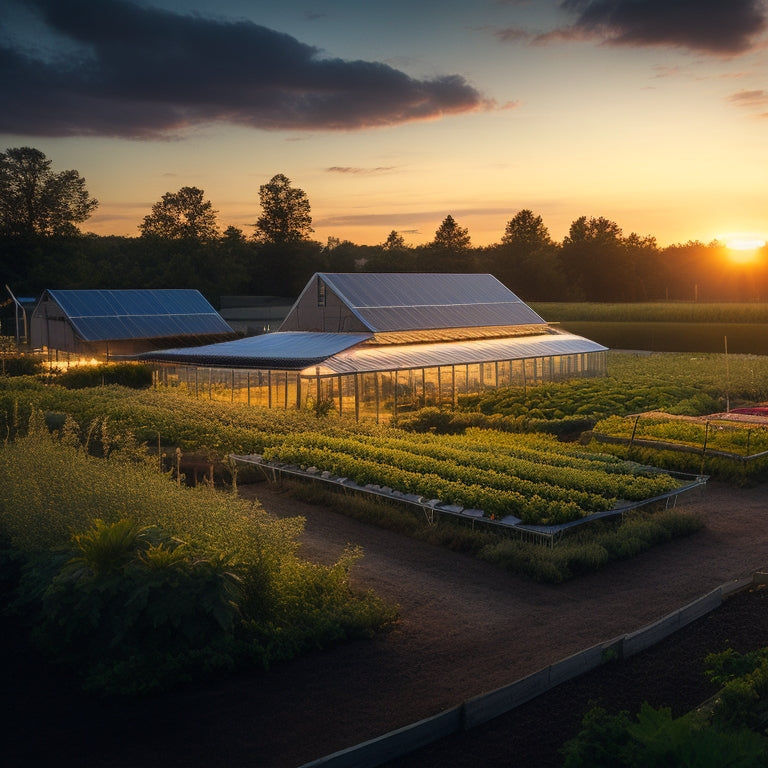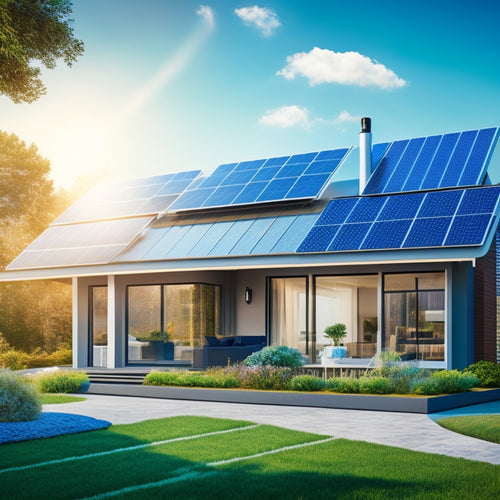
Automate Your Urban Farm With Solar-Powered Solutions
Share
You can utilize the power of solar energy to automate your urban farm, increasing efficiency and reducing your reliance on non-renewable energy sources. By integrating solar-powered irrigation systems, automated crop monitoring tools, and energy collection solutions, you'll optimize crop yields, minimize waste, and decrease your carbon footprint. With smart greenhouse climate control and vertical farming automation, you'll streamline operations and allocate resources more effectively. As you investigate the potential of solar-powered farming equipment and renewable energy integration, you'll reveal new opportunities to enhance your urban farm's sustainability and productivity - and uncover how to take your operation to the next level.
Key Takeaways
- Solar-powered solutions reduce reliance on non-renewable energy sources, integrating renewable energy sources to decrease carbon footprint and increase energy efficiency.
- Automated crop monitoring tools optimize crop yields and minimize waste through real-time data on soil moisture and crop health.
- Solar-powered irrigation systems integrate solar pumps with drip irrigation for efficiency, while regular maintenance prevents up to 20% efficiency loss.
- Smart greenhouse climate control maintains optimal temperature, humidity, and light levels through sensors and automation, ensuring real-time climate adjustments.
- Renewable energy integration powers infrastructure like irrigation, lighting, and refrigeration, reducing reliance on fossil fuels and contributing to a decreased environmental impact.
Solar-Powered Irrigation Systems
Solar-powered irrigation systems can markedly reduce your urban farm's reliance on non-renewable energy sources and lower your water bills.
By integrating solar pumps with drip irrigation, you can optimize energy efficiency and water conservation. Regular maintenance, including cleaning and inspecting connections, is essential for optimizing performance and ensuring longevity, as regular cleaning of solar panels can prevent up to 20% efficiency loss.
System integration with weather forecasting allows you to adjust irrigation schedules according to weather conditions, ensuring your crops receive the right amount of water.
With remote monitoring, you can track your system's performance and make data-driven decisions to optimize crop rotation, nutrient management, and sustainable practices. This results in healthier crops, reduced energy consumption, and a lower environmental impact.
Automated Crop Monitoring Tools
You can optimize crop yields and reduce waste by implementing automated crop monitoring tools in your urban farm.
These tools provide critical information into soil moisture levels, crop health, and real-time data tracking, enabling you to make data-driven decisions.
Additionally, integrating solar-powered solutions can reduce grid reliance and carbon footprint, similar to solar energy reduces grid dependence, and enhance energy self-sufficiency.
Soil Moisture Sensors
Soil moisture sensors are an essential component of automated crop monitoring systems, as they provide real-time data on soil moisture levels, allowing urban farmers to optimize irrigation schedules and guarantee their crops receive the right amount of water. By installing these sensors, you'll be able to monitor soil health and moisture retention, making sure your crops thrive.
| Sensor Type | Benefits |
|---|---|
| Tensiometers | Measure soil water tension, ideal for sandy soils |
| Resistive Sensors | Accurate readings in a wide range of soil types |
| Capacitive Sensors | Non-invasive, suitable for clay and loamy soils |
With real-time data, you can adjust your irrigation schedule to verify your crops receive the perfect amount of water, reducing waste and saving resources. By automating soil moisture monitoring, you'll have more time to focus on other aspects of your urban farm, giving you the freedom to grow a thriving and sustainable crop.
Crop Health Analysis
Crop health analysis, an essential component of automated crop monitoring systems, enables urban farmers to detect early signs of stress, disease, or pests, facilitating prompt intervention and minimizing crop loss.
By utilizing solar power integration Renewable Energy Solutions to reduce grid reliance and carbon footprint, urban farmers can create a more sustainable and eco-friendly environment for their crops.
You can utilize advanced sensors and cameras to capture high-resolution images of your crops, which are then analyzed using machine learning algorithms to identify potential issues. This allows you to take targeted action, such as adjusting pest management strategies or enhancing nutrient delivery, to prevent the spread of disease and guarantee peak growth.
Real-Time Data Tracking
Advanced monitoring capabilities are key to optimizing urban farm operations, and real-time data tracking is a critical component of this process. With automated crop monitoring tools, you can collect and analyze data on temperature, humidity, soil moisture, and light intensity.
This data is then integrated with sensor information to provide a thorough view of your farm's performance. You'll be able to identify trends, detect anomalies, and make data-driven decisions to optimize crop yields and reduce waste.
By leveraging sustainable charging solutions and eco-friendly practices, urban farms can minimize their carbon footprint and contribute to a sustainable future.
Data visualization tools enable you to easily interpret complex data, while sensor integration guarantees seamless communication between devices.
Energy Harvesting for Farming
You'll need a reliable energy source to power your urban farm's automation systems, which is where renewable energy sources come in. By utilizing energy from the sun, wind, or water, you can reduce your reliance on the grid and lower your operating costs.
Off-grid power systems, such as solar panels or wind turbines, can be integrated into your farm's design to provide a consistent and sustainable energy supply. For instance, electric vehicle charging stations can be customized to power your farm's electric vehicles, reducing fossil fuel reliance.
Additionally, solar panels can provide supplementary power, extending the range of your farm's electric vehicles and reducing recharging needs.
Renewable Energy Sources
Beyond the city limits, your urban farm relies on a steady supply of energy to power irrigation systems, greenhouses, and other essential infrastructure.
You're likely considering renewable energy sources to reduce your carbon footprint and increase energy efficiency. You have several options, including wind energy, biomass energy, and geothermal energy.
Hydroelectric power is another viable option if you have a nearby water source. By incorporating these sustainable energy sources, you'll be practicing permaculture principles and contributing to sustainable agriculture.
Energy storage solutions will help you make the most of your harvested energy. Additionally, community solar programs can provide an alternative to traditional energy sources.
Off-Grid Power Systems
As you investigate renewable energy sources for your urban farm, incorporating off-grid power systems can greatly reduce your reliance on traditional energy providers.
These systems allow you to generate and store energy independently, ensuring a consistent supply even during grid outages. A key component of off-grid power systems is battery storage, which enables you to store excess energy generated during the day for use at night or during periods of low energy production.
Smart Greenhouse Climate Control
In today's urban farming environment, maintaining ideal climate conditions within your greenhouse is crucial for crop health and productivity. You need to guarantee optimal temperature, humidity, and light levels to maximize yields. Smart greenhouse climate control systems can help you achieve this. These systems use sensors and automation to monitor and adjust climate conditions in real-time, guaranteeing optimal growth conditions for your crops.
| Climate Control Parameter | Optimal Range |
| Temperature | 18-24°C (64-75°F) |
| Humidity | 50-70% |
| Light | 400-700 μmol/m²s |
Vertical Farming Automation Solutions
You've optimized your greenhouse climate, now it's time to maximize your space.
Vertical farming automation solutions allow you to increase crop yields while minimizing land use. Implementing hydroponic systems enables precise nutrient management, reducing waste and ensuring ideal plant growth.
Automated irrigation and fertilization systems streamline crop care, freeing you to focus on higher-value tasks. By integrating sensors and monitoring systems, you can track crop health and adjust growing conditions in real-time.
This data-driven approach enables you to make informed decisions, increasing efficiency and profitability. With vertical farming automation, you can grow more with less, enjoying greater freedom and flexibility in your urban farm operation.
Solar-Charged Farming Equipment
Your farm's reliance on fossil fuels can be a considerable expense and environmental concern. By switching to solar-charged farming equipment, you can reduce your carbon footprint and lower your energy costs.
Consider the following benefits of solar-powered equipment:
-
Increased energy independence: With solar energy storage, you're no longer tied to the grid or reliant on fossil fuels.
-
Reduced operating costs: Solar power can considerably reduce your energy expenses, freeing up resources for other aspects of your farm.
-
Alignment with sustainable farming practices: Solar-powered equipment supports environmentally friendly farming methods, enhancing your farm's reputation and appeal.
Renewable Energy for Farm Operations
Beyond the specific applications of solar-charged farming equipment, renewable energy can be integrated throughout your farm operations to further reduce reliance on fossil fuels and lower your environmental impact.
You can power your farm's infrastructure, such as irrigation systems, lighting, and refrigeration, with solar or wind energy. This not only reduces your carbon footprint but also saves you money on energy costs.
By adopting sustainable practices, you're contributing to a healthier environment and setting an example for your community. Involving your community in your renewable energy efforts can encourage community engagement and education on the importance of sustainable agriculture.
Frequently Asked Questions
Can Solar-Powered Solutions Be Integrated With Existing Urban Farm Infrastructure?
Like a puzzle piece fitting perfectly into place, you'll find that integrating solar-powered solutions with your existing urban farm infrastructure is a seamless process, allowing you to utilize the power of solar panel integration and state-of-the-art urban farming technology to maximize your harvest.
How Do I Determine the Ideal Solar Panel Size for My Urban Farm?
To determine the ideal solar panel size, you'll calculate your urban farm's energy consumption, considering factors like lighting, irrigation, and climate control, then select a panel that meets or exceeds that energy need, ensuring a reliable and efficient power supply.
Are Solar-Powered Solutions Compatible With All Types of Crops?
You'll find that solar-powered solutions are generally compatible with most crops, but crop compatibility and solar efficiency vary depending on factors like shading, temperature, and moisture requirements, so research your specific crops to guarantee ideal pairing.
Do Solar-Powered Solutions Require Frequent Maintenance and Repairs?
You'll find that solar-powered systems, in general, are designed for system longevity, minimizing maintenance costs; however, you'll still need to perform routine checks and occasional repairs to guarantee peak performance and extend the system's lifespan.
Are There Any Government Incentives for Adopting Solar-Powered Urban Farming Solutions?
You'll find that government incentives for sustainable farming practices, like the USDA's Natural Resources Conservation Service grants, can provide up to 75% funding for solar-powered irrigation systems, while federal tax credits can cover 30% of total project costs.
Related Posts
-

7 Best Cool Roof Rebates for Energy-Savvy Homeowners
You're an energy-savvy homeowner looking to install a cool roof, and you're wondering which rebates can help you save...
-

Smart Energy: Greener Homes With Connected Power Devices
You can control and optimize your energy consumption with smart energy devices, reducing your carbon footprint by up ...
-

7 Solar-Safe Window Solutions for Earth-Conscious Homeowners
As an earth-conscious homeowner, you're likely keen to find solar-safe window solutions that align with your values. ...


